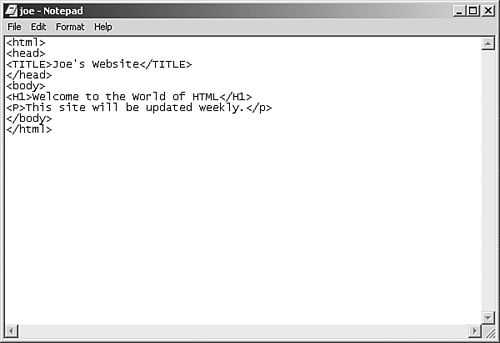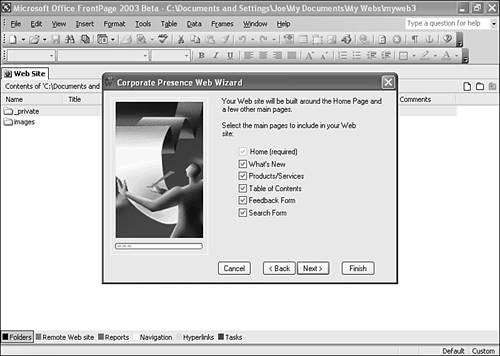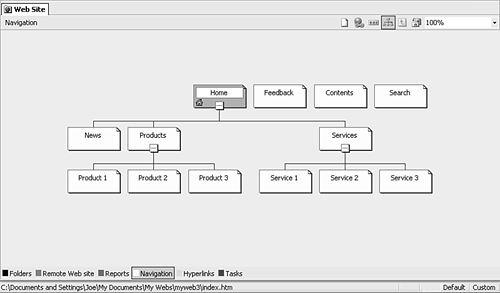Creating a Web Site
| Although the development of the Hypertext Transport Protocol (HTTP) provided the underlying communication structure for the World Wide Web, the authoring language used to create Web pages is the Hypertext Markup Language (HTML). HTML consists of embedded tags that tell a Web browser how to display or act upon information found on a Web page. Your Web site, no matter how modest, will typically consist of multiple Web pages; the home page, which is the main page for the site, will provide the table of contents for the site. Each additional page on the site will be referenced on the home page by a hyperlink. A hyperlink is basically a pointer that allows you to refer to other local Web pages, graphics, and multimedia content on a page. When a hyperlink is clicked in a Web browser window, the user is taken to that page or a particular event is activated (such as the playing of video or audio content or the displaying of a picture). Hyperlinks can also be used to refer to remote Web pages or other locations, such as an FTP site. In the Web's infancy, Web pages primarily consisted of text and hyperlinks. Images were used to provide some respite, but it took some time to develop tools that provided more complex multimedia content on a Web page. Java applets now provide us with applications that can be run directly from Web pages. Also, multimedia plug-ins such as Macromedia Shockwave and Flash, Real Player, and Windows Media Player provide you with the ability to access audio and video content in a Web page. As far as Web page design goes, your aim is to produce a Web site that is informational, easy to navigate, and esthetically pleasing. Web site design not only requires an understanding of HTML (and any plug-in technologies that you use), but it also requires an eye for design. Although I'm not saying you need to be an artist or a design expert to create a decent Web site, it certainly doesn't hurt to understand some basic design and layout concepts. Although we will take a quick look at how you would create a Web site using either HTML or a software design tool, there are many other resources that can walk you through the entire process of Web site creation and help you develop some appreciation for design concepts. In fact, there are probably enough books on Web site design and the various tools for creating Web sites to bridge the Atlantic Ocean between the United States and Europe. Check out www.quepublishing.com or www.samspublishing.com for a number of titles. Working with HTMLIf you want to create your Web pages from scratch, you can use any text editor. As already mentioned, HTML is made up of a system of tags that are applied to text in an ASCII text file. All HTML tags are written in the format <code> , where code would be the actual HTML tag you are using. For example, to center text on a Web page, the HTML code would appear as follows : <CENTER>This text will be centered</CENTER> Note that one tag is used to turn the centering on ( <CENTER> ) and a very similar tag that includes a slash ( / ) turns off the centering (the </CENTER> tag).I think you can see that HTML is somewhat intuitive. When you begin a Web page that you are creating in HTML, the first tag at the top of the HTML document is <HTML> . Other tags follow as needed. For example, the <HEAD> tag is used to specify the part of the HTML document that contains the title for the Web page. The title of the Web page is then specified using the tag <TITLE> . For example, let's say I want to create a simple Web page using Windows Notepad. My HTML code will actually start with the tag <HTML> . To end the page, I use the tag </HTML> . Every "on" tag has a counterpart "off" tag. Figure 16.6 shows the beginnings of a very simple Web page written in HTML using Windows Notepad. Your text files need to be saved with the extension .htm to be read by a Web browser. Figure 16.6. Web pages can be created directly in HTML using a text editor such as Windows Notepad. As you work on your HTML documents, you can check your work by opening the file in any Web browser. Figure 16.7 shows the HTML document in Figure 16.6 as it would appear in Internet Explorer. Figure 16.7. HTML documents can be viewed in any Web browser. This way, you can see how your HTML coding is working out. The Web actually provides some very good resources for learning HTML. For example, check out an online HTML tutorial at http://davesite.com/webstation/html/. A good HTML reference book that will also provide you with some background information on Web design is Special Edition Using HTML and XHTML , from Que. Web Design ToolsA number of Web design tools are available that allow you to create Web sites and Web pages without having to face the laborious task of coding each page in HTML. Examples include Macromedia Dreamweaver and Microsoft FrontPage (and there are many others). These Web design tools provide a number of different strategies to help you with page design and adding special elements to your Web pages, such as pictures and multimedia content. For example, Microsoft FrontPage provides a number of wizards that can be used to create different types of Web sites (see Figure 16.8). Figure 16.8. FrontPage provides a number of wizards that can be used to create different kinds of Web sites. Note
These wizards can create Web sites that range from a corporate-presence Web site, to a customer-support Web site, to a simple one-page Web site. Each of these wizards walks you through the creation of the different pages and objects that will be part of the Web site by asking you a series of questions. Figure 16.9 shows the pages and Web site structure that is created when you use the Corporate Presence Web Wizard in FrontPage 2003. Each page can then be edited and enhanced as needed. Tools such as FrontPage and Dreamweaver function a great deal like desktop publishing software. Figure 16.9. The Web page structure for complex corporate sites can be created using Web development tools such as Microsoft FrontPage. Web design tools certainly make it easier for you to initially create your Web site and update content as required. These tools even provide you with methods for uploading your Web site to your Web server or the ISP server that will host your Web site. For example, FrontPage has a Web publishing feature that uploads your entire site to a specified server. Tip
|
EAN: 2147483647
Pages: 188





